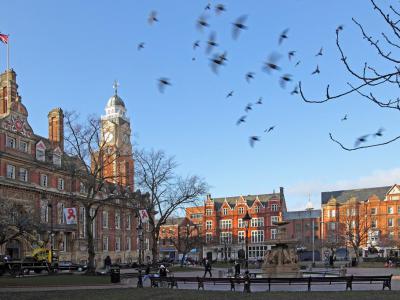Town Hall Square, Leicester
Town Hall Square is a central civic space in Leicester, home to the grand Leicester Town Hall and its striking ornamental fountain. A welcoming public space, the square is an architectural and historical highlight of the city, reflecting Leicester’s evolution from a medieval market town to a modern urban center.
The Leicester Town Hall, a Grade II* listed building, was constructed on the site of the city’s old cattle market after the Guildhall-Leicester’s previous council meeting place-was deemed too small. Designed by architect Francis Hames in the Queen Anne style, the foundation stone was laid on 3 August 1874, and the building officially opened on 7 August 1876. The structure, made from Ketton stone, features an imposing 44-meter-high clock tower and has undergone extensions in 1910 and 1924. A notable event in its history occurred during the Blitz in 1940 when a German bomb crashed through the roof and into the basement, remarkably failing to detonate.
One of the most distinctive features of the square is its grand fountain, a gift from Sir Israel Hart, a former Mayor of Leicester. Unveiled in 1879, the fountain, designed by Hames, incorporates bronze-painted cast iron, Shap granite, and Ross of Mull granite. Though it was once believed to be inspired by a similar fountain in Porto, Portugal, evidence suggests the Leicester fountain predates the Porto version, with strong indications that the latter was a copy.
Town Hall Square is also home to the Second Boer War Memorial, sculpted by Joseph Crosland McClure and unveiled in 1909 by Field Marshal Lord Grenfell. This monument stands as a tribute to Leicester’s military history.
Beyond its historical significance, the square remains a focal point of civic life, housing Leicester City Council and offering a pleasant urban space for residents and visitors alike.
The Leicester Town Hall, a Grade II* listed building, was constructed on the site of the city’s old cattle market after the Guildhall-Leicester’s previous council meeting place-was deemed too small. Designed by architect Francis Hames in the Queen Anne style, the foundation stone was laid on 3 August 1874, and the building officially opened on 7 August 1876. The structure, made from Ketton stone, features an imposing 44-meter-high clock tower and has undergone extensions in 1910 and 1924. A notable event in its history occurred during the Blitz in 1940 when a German bomb crashed through the roof and into the basement, remarkably failing to detonate.
One of the most distinctive features of the square is its grand fountain, a gift from Sir Israel Hart, a former Mayor of Leicester. Unveiled in 1879, the fountain, designed by Hames, incorporates bronze-painted cast iron, Shap granite, and Ross of Mull granite. Though it was once believed to be inspired by a similar fountain in Porto, Portugal, evidence suggests the Leicester fountain predates the Porto version, with strong indications that the latter was a copy.
Town Hall Square is also home to the Second Boer War Memorial, sculpted by Joseph Crosland McClure and unveiled in 1909 by Field Marshal Lord Grenfell. This monument stands as a tribute to Leicester’s military history.
Beyond its historical significance, the square remains a focal point of civic life, housing Leicester City Council and offering a pleasant urban space for residents and visitors alike.
Want to visit this sight? Check out these Self-Guided Walking Tours in Leicester. Alternatively, you can download the mobile app "GPSmyCity: Walks in 1K+ Cities" from Apple App Store or Google Play Store. The app turns your mobile device to a personal tour guide and it works offline, so no data plan is needed when traveling abroad.
Town Hall Square on Map
Sight Name: Town Hall Square
Sight Location: Leicester, England (See walking tours in Leicester)
Sight Type: Attraction/Landmark
Guide(s) Containing This Sight:
Sight Location: Leicester, England (See walking tours in Leicester)
Sight Type: Attraction/Landmark
Guide(s) Containing This Sight:
Walking Tours in Leicester, England
Create Your Own Walk in Leicester
Creating your own self-guided walk in Leicester is easy and fun. Choose the city attractions that you want to see and a walk route map will be created just for you. You can even set your hotel as the start point of the walk.
Historical Buildings
Leicester, a city in England's East Midlands, has a storied past that is vividly presented in its historical buildings. Valuable architectural monuments, they are the city's pride and as such enjoy special protection by the government.
Among such, Magazine Gateway stands as a testament to the city's medieval legacy. Originally part of its defensive walls, this structure now... view more
Tour Duration: 2 Hour(s)
Travel Distance: 2.6 Km or 1.6 Miles
Among such, Magazine Gateway stands as a testament to the city's medieval legacy. Originally part of its defensive walls, this structure now... view more
Tour Duration: 2 Hour(s)
Travel Distance: 2.6 Km or 1.6 Miles
Leicester Introduction Walking Tour
Leicester is one of the oldest cities in England, whose history goes back almost two millennia. The Romans arrived in the area around 47 AD, during their conquest of southern Britain. Following the Saxon invasion, Leicester was then captured by Danish Vikings, in the 9th century.
The settlement was first documented in the early 10th century, under the name Ligeraceaster. At the time of the... view more
Tour Duration: 1 Hour(s)
Travel Distance: 1.1 Km or 0.7 Miles
The settlement was first documented in the early 10th century, under the name Ligeraceaster. At the time of the... view more
Tour Duration: 1 Hour(s)
Travel Distance: 1.1 Km or 0.7 Miles





